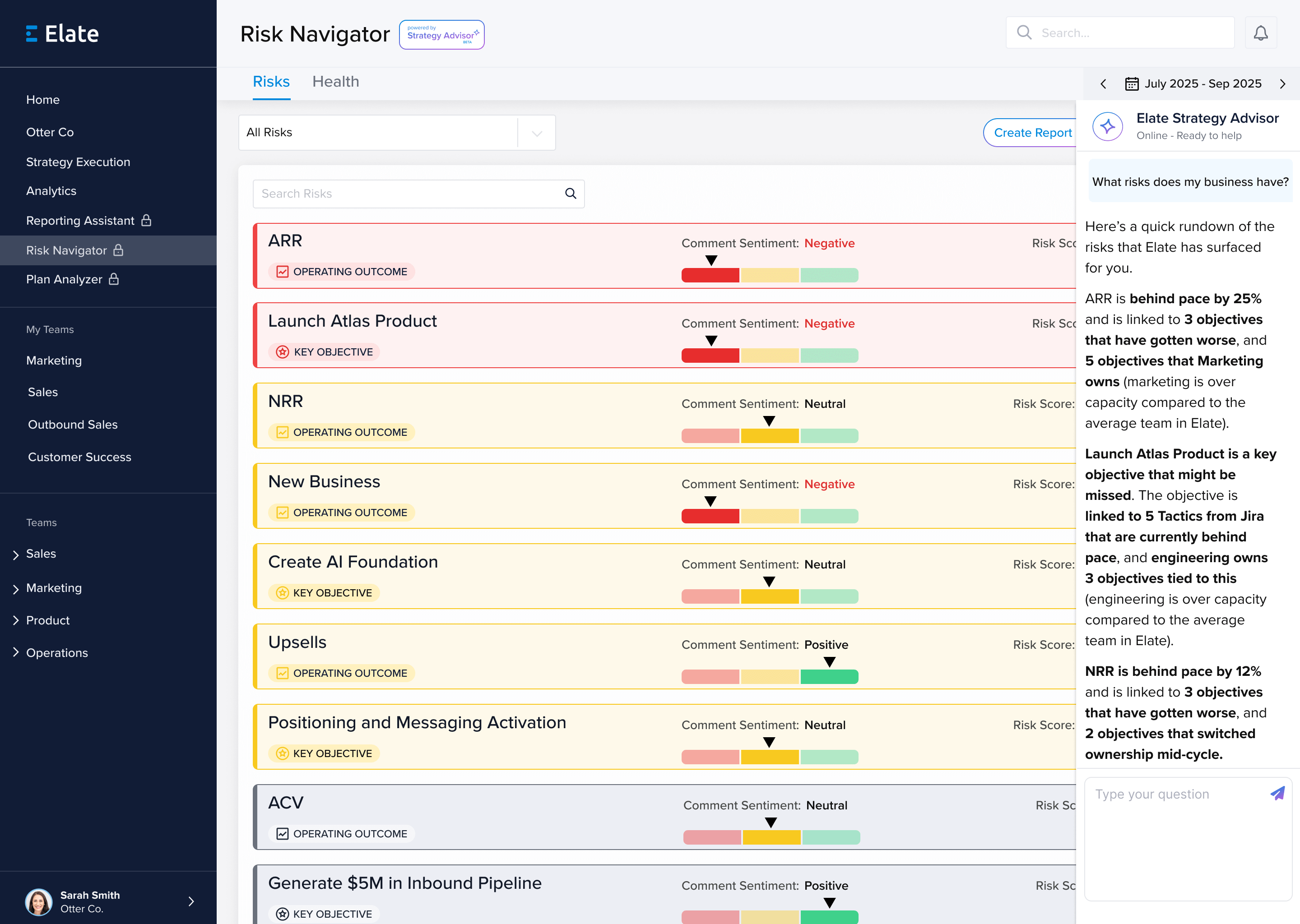For today's leading high growth businesses, adding an operating framework for scale is essential to unlocking the opportunities across your company. At Elate, we've seen firsthand the power of adding structure to unify the collective efforts of your team and harness momentum in a single direction.
Over the past few years there have been a number of different frameworks introduced to help provide a blueprint for companies. From OKRs (Objectives and Key Results) and EOS (Entrepreneurial Operating System) to MBOs (Management by Objectives), V2MOM, and 4DX (Four Disciplines of Execution), there are a number of operating frameworks that can help your business think about sustainable, long term growth.
Most recently, the OKR framework has continued to gain traction, especially within the high growth community. And while we are big fans of OKRs here at Elate, we often receive common questions or misunderstandings about OKRs and how they can work for your team. Specifically, companies often think OKRs replace the need for metrics or KPIs within their business.
To begin with the acronym OKR stands for 'Objectives and Key Results,’ and this structure of objectives tied to outcomes. Objectives without Key Results won't lead to a tangible, measurable outcome, and Key Results without Objectives will have nothing to measure. From the first OKRs Google made popular to the original use of OKRs at Intel, it's important to understand that Objectives should drive your team's focus and efforts, but the Key Results of those Objectives are how you measure success.
So instead of performing a Google search of 'What is OKR' or 'OKR vs KPI', let us share a bit more about the OKR framework, and how we see companies successfully implement a structure and cadence for tracking both.
OKR Framework
The beginnings of any great framework come with an understanding that it isn't one-size fits all. In fact, the Google OKR framework was tailored towards their company's culture, as was Intel's and countless others. The OKR methodology is an incredible framework for helping your company prioritize the most important areas of your business, and align those to your company's long term vision.
Objectives and Key Results or OKRs are a collaborative, team-centric goal-setting framework that helps power growth and direction for your business. The structure allows companies to set, track, and measure the outcomes of company objectives.
One of the most distinct attributes of the OKR framework is that the structure helps reinforce a cadence and rhythm for regularly reviewing company objectives and ensuring that objectives throughout the company are aligned. From the leadership team to every individual contributor, OKRs help keep everyone pointed in the right direction as the company continues to progress towards a common goal.
This reinforcement of alignment and visibility can be especially powerful at a high growth company that is managing constant chaos and growth. While it is easy for growth stage businesses to fall on the excuse that a traditional strategic planning structure or operating framework isn't suited for the ever-changing dynamic of their company, OKRs are well-suited to help maximize growth in this environment.
Often OKRs are set at the leadership team level and aligned towards how the company achieves quarterly or annual success in a way that brings the company closer to its long term vision. Once objectives are set at a leadership level, they can be cascaded to managers and individual contributors.
At the leadership level, the company will usually take on three to five objectives, and while managers or directors could also have three to five, it is more common to see two to three objectives at the management level. When objectives reach the individual contributor level, it is usually recommended to have one or two objectives.
The process of setting objectives that align with a hierarchy is critical to the OKR framework, as is measuring success of the desired outcomes for each objective.
This is where the question of KPIs vs OKRs often comes into play. And while measuring successful OKR metrics is critical to success, the reality is key results associated with objectives can also tie into larger company metrics to be reported on regularly.
As we'll discuss a bit later on, the OKR and KPI question can often result in an OKR and KPI together. But first, let's walk through an example of OKRs and how metrics tie into measuring success of your company's objectives.
OKR Examples
As you can probably guess, setting an OKR first starts with defining your Objective. Let's take a look at some OKR examples for growth stage companies:
Example One:
Objective: Deliver a Best in Class Customer Implementation Process
Key Results:
1. Decrease implementation timeline from 45 days to 30 days.
2. Increase Net Promoter Score from X to Y.
3. Build and maintain five pre-built API integrations.
Example Two:
Objective: Release Customer Learning Series to Delight Customers
Key Results:
1. Increase Daily Active User and Monthly Active User score to 50%
2. Increase Net Promoter Score from X to Y.
3. Maintain Customer Renewal Rate of 95%
In the above real OKR examples, it starts with an Objective that has clearly defined Key Results that lead to success. These Key Results should tie into your overall strategic plan and goals for the year.
In looking at OKRs explained and taking these back to your company, every Objective throughout your business should reinforce the financial goals you've outlined for the year. From net new revenue growth to NPS and even product features that require budgeting and hiring, each Objective ties into a larger plan. For this larger plan, there are KPIs you are aiming to hit that are reinforced or supported by those Key Results set at the Objective-level.
Which leads us to our final topic: how OKRs and KPIs can exist together.
OKR and KPI Together
At one point or another most strategy and ops leaders are asked the question of the difference between an OKR vs KPI vs MBO or even OKR vs SMART Goals. And the reality is that in the case of OKRs vs KPIs, they can actually co-exist. Frankly, KPIs can exist with any operating framework.
But when it comes to specifically OKRs, you can have an OKR and KPI together.
As we've shared, OKRs are a goal-setting framework designed to align your entire company and unify the work and effort of every team member around a long term vision. However, from working with some of the leading strategy and ops leaders at every stage of the company, there are always going to be KPIs that should be top of mind and central in how you review the ongoing health of your business.
From Annual Recurring Revenue and Retention Rate to NPS and Upsells, certain KPIs are essential to your business and need to be reviewed, reported, and discussed regularly.
And while most of these metrics might live as Key Results tied to an Objective, the reality is there might be a season or quarter where your business doesn't have company level objectives that tie to these metrics. Further, as you start to think about metrics, such as gross margin, run rate, cash on hand, etc, these are financial metrics tied to the operating health of the business. However, these might not be tied to team objectives or even metrics you feel comfortable reporting to the entire company.
Meet Elate
As it becomes more and more important for companies to build alignment and unify teams around long term goals in a hybrid environment, visibility, transparency, and communication will play a pivotal role in providing a blueprint for success. As you think about an operating framework and evaluate OKRs pros and cons, or any other goal setting framework, keep in mind that any framework is only as good as the adoption, cadence, and regularity in which you use it.
From setting KPIs that provide a glimpse into the health of your business to building and cascading your quarterly OKRs, leveraging a solution to help drive advocacy across the business can make or break the rollout of any framework.
Far too many companies have been stung trying to use a free OKR tool or a solution that just isn't designed to account for your team's structure.
We know, because we've been there.
Elate is the leading Strategic Planning software built to help SaaS companies communicate their vision, create alignment, and track performance all in one place. It was built out of the pain we experienced as strategy and ops leaders at growth stage companies.
From our professional service offerings designed to help you find the right solution to our easy, intuitive onboarding, Elate is built to set you up for success from day one.
Whether you are reviewing KPIs in leadership team meetings, highlighting key wins in company all-hands meetings, or walking through OKRs with your Board, Elate solves the pain of implementing an operating framework.
If you're interested in learning more about how we are working with the leading strategy and ops leaders, reach out to our team today. We'd love to share what we've built for you and your company!











